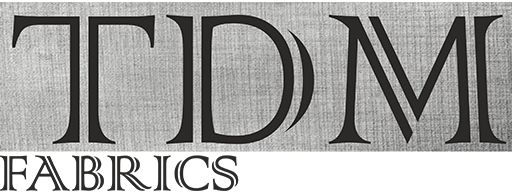Find out about different type of fabrics.
- Cambric:
A lightweight plain weave cotton or linen cloth, slightly heavier than muslin, that is closely woven and calendered to give a slight sheen on one side. - Chambray:
A plain woven fabric, typically made from cotton or synthetic fibers, that is often woven in checkered or striped patterns and has a frosted appearance. Usually made from blue and white yarns and used to make shirts, dresses and childrens clothing. - Cotton Canvas:
Plain weave fabric with a substantial weight may be termed canvas. - Cotton Corduroy:
Corduroy is a cut pile fabric, and is described using the term wales, this refers to raised ridges or ribs that run vertically down the fabric parallel to the selvedge. The wider the wales the lower the numerical expression, wale count being the number of wales that fit into one inch (2.5 cm) - Cotton Denim:
Denim is of a rugged twill construction in which the weft passes under two or more warp yarns, which produces a diagonal rib effect. Traditional denim uses indigo dyed warps and white/ undyed wefts. The weft passes under two or more warp fibers, which produces a diagonal ribbing found on the reverse of the fabric. The twill construction causes one color (blue is most common) to dominate the fabric’s surface. However, denim might be made of any color yarn, hence the front shows more blue and back is white. - Cotton Drill:
Drill is a diagonal weave fabric similar to the twill weave, but drill has a much more profound diagonal rib surface effect. This is due to coarser yarn count, which provides added durability. - Cotton Duck:
Duck is a stronger and more robust type of canvas. It is also plain weave construction but with a higher count than standard canvas. Two warp yarns are often together which gives additional strength to the fabric. Often used to make deck shoes and similar footwear. - Cotton Jacquard:
The diamond design of this fabric is referred to as jacquard weave. - Cotton Poplin:
Poplin is a strong, medium-weight, plain weave fabric. The warp threads are finer and more closely set than the weft threads which are also a little heavier giving fabric a slight rib effect. Light weight poplin fabrics are good for shirts, while medium weight poplin fabrics due to its strength are suitable for trousers. - Cotton Satin:
A satin weave construction lends cotton a smooth surface sheen. The touch and drape of the fabric is both dense and pliable. Satin construction provides the fabric greater structure and sophistication. These have a finer yarn counts and a greater thread count. It has a predominance of weft threads on the face side of the fabric giving it a pliable touch. - Cotton Twill:
A classic diagonal fabric, twill fabrics come in a variety of weights and qualities. Each is suited to different clothing products, from fine shirts to heavy outerwear and traditional trench coats. - Cotton Velvet:
Velvet is a luxurious pile fabric, which is traditionally associated with silk, cotton and linen. The touch and drape of velvet fabric can range from stiff and dense through to fine and fluid. The personality of the fabric will depend upon the weight and the fiber of the fabric. - Dobby:
A type of weave using for decorations, featuring woven geometric patterns. - Linen Heavyweight:
Plain open weave with relatively coarser yarn, creating a visually pronounced surface. - Linen Lightweight:
A lightweight plain weave rendering both fine and smooth textures. Linen yarn is firmer and stronger compared to similar weight cotton yarn, which allows it to be more loosely woven for added comfort in hot climate without compromising the fabrics stability. This weight is perfect for tropical shirts, tops and dresses. Unlike other yarns, linen improves with age and through wearing and washing. - Lycra:
The trademark name for DuPont’s brand of Spandex fiber. - Modal:
Made from spun Beechwood cellulose, the bio-based fibers create textiles that do not fibrillate, or pill, and are resilient to shrinking and fading. A bio-based fiber made by spinning reconstructed cellulose from beech trees. It is designed to dye just like cotton and is color-fast when washed in warm water. Modal is essentially a variety of rayon. Textiles made from Modal are resistant to shrinkage and fading. They are smooth and soft, more so than mercerized cotton, to the point where mineral deposits from hard water do not stick to the fabric. Like pure cotton, modal is ideally ironed after washing. - Rayon:
Rayon is a regenerated cellulose fiber, manufactured from wood pulp. This straight weave lightweight quality is an inexpensive fabric with good draping qualities and is suitable for multiple uses. - Ribstop:
Ribstop fabric is made by using a special weave technique that makes it resistant to tearing and ripping. During weaving, thick and strong reinforcement threads are interwoven at regular intervals in a crosshatch pattern. - Slub: the fabric is made from varying qualities and thickness of the yarn, making the fabric bumpy.
- Spandex:
Made with elastic fibers that can be stretched up to five times its original length without damage. When blended with natural fibers, it creates a lightweight and flexible fabric with great shape retention. - Tencel:
A fabric made from the cellulose of wood pulp, then processed into a silk-like fabric that is very soft with great drape. It’s usually a medium weight fabric that can be easily dyed and cared for. - Viscose:
Also known as rayon or viscose rayon. Cellulose from wood or cotton fibre is used to make viscose rayon. - Yarn-dyed:
Describing fabric that is woven or knitted from yarns already dyed rather than gray goods dyed after weaving.
